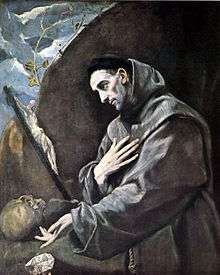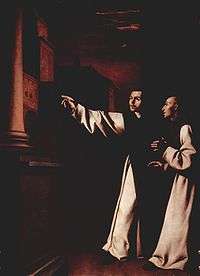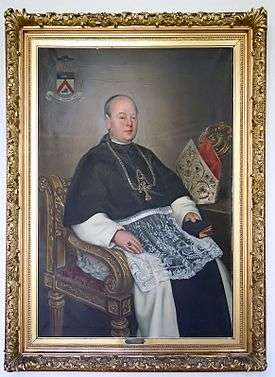Religious order (Catholic)
In the Catholic Church, a religious order is a community of consecrated life with members that profess solemn vows. According to the 1983 Code of Canon Law, they are classed as a type of religious institute.
 |
| Part of a series on the |
| Canon law of the Catholic Church |
|---|
|
Jus antiquum (c. 33-1140)
Jus novum (c. 1140-1563) Jus novissimum (c. 1563-1918) Jus codicis (1918-present) Other |
|
Sacraments
Sacred places
Sacred times |
|
|
Supreme authority, particular churches, and canonical structures Supreme authority of the Church
Supra-diocesan/eparchal structures
|
|
|
Temporal goods (property) |
|
Canonical documents |
|
Procedural law Pars statica (tribunals & ministers/parties)
Pars dynamica (trial procedure)
Election of the Roman Pontiff |
|
Legal practice and scholarship
Academic degrees Journals and Professional Societies Faculties of canon law
Canonists |
|
|

Subcategories of religious orders are canons regular (canons and canonesses regular who recite the Divine Office and serve a church and perhaps a parish); monastics (monks or nuns living and working in a monastery and reciting the Divine Office); mendicants (friars or religious sisters who live from alms, recite the Divine Office, and, in the case of the men, participate in apostolic activities); and clerics regular (priests who take religious vows and have a very active apostolic life).
Original Catholic religious orders of the Middle Ages include the Order of Saint Benedict, the Carmelites, the Order of Friars Minor, the Dominican Order, the Order of the Most Holy Trinity and the Order of Saint Augustine. As such, also the Teutonic Order may qualify, as today it is mainly monastic.
In the past, what distinguished religious orders from other institutes was the classification of the vows that the members took in religious profession as solemn vows. According to this criterion, the last religious order founded was that of the Bethlehem Brothers in 1673.[1] Nevertheless, in the course of the 20th century, some religious institutes outside the category of orders obtained permission to make solemn vows, at least of poverty, thus blurring the distinction.
Essential distinguishing mark
Solemn vows were originally considered indissoluble. As noted below, dispensations began to be granted in later times, but originally not even the Pope could dispense from them.[2] If for a just cause a member of a religious order was expelled, the vow of chastity remained unchanged and so rendered invalid any attempt at marriage, the vow of obedience obliged in relation, generally, to the bishop rather than to the religious superior, and the vow of poverty was modified to meet the new situation but the expelled religious "could not, for example, will any goods to another; and goods which came to him reverted at his death to his institute or to the Holy See".[3]
Weakening in 1917
The former 1917 Code of Canon Law reserved the name "religious order" for institutes in which the vows were solemn, and used the term "religious congregation" or simply "congregation" for institutes with simple vows. The members of a religious order for men were called "regulars", those belonging to a religious congregation were simply "religious", a term that applied also to regulars. For women, those with simple vows were called "sisters", with the term "nun" reserved in canon law for those who belonged to an institute of solemn vows, even if in some localities they were allowed to take simple vows instead.[4]

However, it abolished the distinction according to which solemn vows, unlike simple vows, were indissoluble. It recognized no totally indispensable religious vows and thereby abrogated for the Latin Church the special consecration that distinguished "orders" from "congregations", while keeping some juridical distinctions.[3]
In practice, even before 1917 dispensations from solemn religious vows were being obtained by grant of the Pope himself, while departments of the Holy See and superiors specially delegated by it could dispense from simple religious vows.[5]
The 1917 Code maintained a juridical distinction by declaring invalid any marriage attempted by solemnly professed religious or by those with simple vows to which the Holy See had attached the effect of invalidating marriage,[6] while stating that no simple vow rendered a marriage invalid, except in the cases in which the Holy See directed otherwise.[7] Thus members of "orders" were barred absolutely from marriage, and any marriage they attempted was invalid. Those who made simple vows were obliged not to marry, but if they did break their vow, the marriage was considered valid.
Another difference was that a professed religious of solemn vows lost the right to own property and the capacity to acquire temporal goods for himself or herself, but a professed religious of simple vows, while being prohibited by the vow of poverty from using and administering property, kept ownership and the right to acquire more, unless the constitutions of the religious institute explicitly stated the contrary.[8]
After publication of the 1917 Code, many institutes with simple vows appealed to the Holy See for permission to make solemn vows. The Apostolic Constitution Sponsa Christi of 21 November 1950 made access to that permission easier for nuns (in the strict sense), though not for religious institutes dedicated to apostolic activity. Many of these latter institutes of women then petitioned for the solemn vow of poverty alone. Towards the end of the Second Vatican Council, superiors general of clerical institutes and abbots president of monastic congregations were authorized to permit, for a just cause, their subjects of simple vows who made a reasonable request to renounce their property except for what would be required for their sustenance if they were to depart.[9] These changes resulted in a further blurring of the previously clear distinction between "orders" and "congregations", since institutes that were founded as "congregations" began to have some members who had all three solemn vows or had members that took a solemn vow of poverty and simple vows of chastity and obedience.
Further changes in 1983
The current 1983 Code of Canon Law maintains the distinction between solemn and simple vows,[10] but no longer makes any distinction between their juridical effects, including the distinction between "orders" and "congregations". Instead, it uses the single term "religious institute" to designate all such institutes.[11][12]
While solemn vows once meant those taken in what was called a religious order, "today, in order to know when a vow is solemn it will be necessary to refer to the proper law of the institutes of consecrated life."[13]
"Religious order" and "religious institute" tend indeed to be used now as synonyms, and canon lawyer Nicholas Cafardi, commenting on the fact that the canonical term is "religious institute", can write that "religious order" is a colloquialism.[14]
Authority structure

A religious order is characterized by an authority structure where a superior general has jurisdiction over the order's dependent communities. An exception is the Order of St Benedict which is not a religious order in this technical sense, because it has a system of "independent houses", meaning that each abbey is autonomous. However, the Constitutions governing the order's global "independent houses" and its distinct "congregations" (of which there are twenty) were approved by the pope. Likewise, according to rank and authority, the abbot primate's "position with regard to the other abbots [throughout the world] is to be understood rather from the analogy of a primate in a hierarchy than from that of the general of an order like the Dominicans and Jesuits." [15]
The Canons Regular of Saint Augustine are in a situation similar to that of the Benedictines. They are organized in eight "congregations", each headed by an "abbot general", but also have an "Abbot Primate of the Confederated Canons Regular of Saint Augustine". And the Cistercians are in thirteen "congregations", each headed by an "abbot general" or an "abbot president", but do not use the title of "abbot primate".
List of religious orders in the Annuario Pontificio

The Annuario Pontificio lists for both men and women the institutes of consecrated life and the like that are "of pontifical right" (those that the Holy See has erected or approved by formal decree).[16] For the men, it gives what it now calls the Historical-Juridical List of Precedence.[17] This list dates back many decades. It is found, for instance, in the 1964 edition of the Annuario Pontificio, pp. 807–870, where the heading is "States of Perfection (of pontifical right for men)". In the 1969 edition the heading has become "Religious and Secular Institutes of Pontifical Right for Men", a form it kept until 1975 inclusive. Since 1976, when work was already advanced on revising the Code of Canon Law, the list has been qualified as "historical-juridical" and still labels as orders the institutes for men of the Latin Church. However, it does not distinguish between orders and congregations in the case of the Eastern Catholic Churches and Latin Church women.
Within that long list, a relatively small section is devoted to Latin-Rite orders for men:
| Canons Regular | |||
| Official Name | Abbreviation | Common Name | |
| Sacer et Apostolicus Ordo Canonicorum Regularium S. Augustini | C.R.S.A. | Canon Regulars, Augustinian Canons | |
| Congregatio Sanctissimi Salvatoris Lateranensis | C.R.L. | Canons Regular of the Lateran | |
| Candidus et Canonicus Ordo Praemonstratensis | O. Praem. | Norbertines or Premonstratensians | |
| Ordo Canonicorum Regularium Sanctae Crucis | O.R.C. | Canons Regular of the Holy Cross of Coimbra | |
| Ordo Fratrum Domus Hospitalis Sanctae Mariae Teutonicorum in Jerusalem | O.T. | (formerly Teutonic Knights) German Order | |
| Canonici Regulares Ordinis S. Crucis | O.S.C. | Crosier Fathers and Brothers | |
| Canonici Regulares Sanctissimae Crucis a stella rubea | O.M.C.R.S. | Knights of the Cross with the Red Star | |
| Monastic Orders | |||
| Official Name | Abbreviation | Common Name | |
| Ordo Sancti Benedicti | O.S.B. | Benedictines (20 congregations) | |
| Congregatio Eremitarum Camaldulensium Montis Coronae | O.S.B.Cam. | Camaldolese (joined the Benedictine confederation) | |
| Ordo Cisterciensis | O. Cist. | Cistercians (13 congregations) | |
| Ordo Cisterciensis Strictioris Observantiae | O.C.S.O. | Trappists | |
| Ordo Cartusiensis | Cart. | Carthusians | |
| Ordo Fratrum S. Pauli Primi Eremitae | O.S.P.P.E. | Pauline Fathers | |
| Ordo Sancti Hieronymi | O.S.H. | Hieronymites | |
| Ordo Libanensis Maronitarum | O.L.M. | Baladites | |
| Mendicant Orders | |||
| Official Name | Abbreviation | Common Name | |
| Ordo Fratrum Praedicatorum | O.P. | Dominicans | |
| Ordo Fratrum Minorum | O.F.M. | Franciscans | |
| Ordo Fratrum Minorum Conventualium | O.F.M. Conv. | Conventual Franciscans | |
| Ordo Fratrum Minorum Capuccinorum | O.F.M. Cap. | Capuchin Franciscans | |
| Tertius Ordo Regularis S. Francisci | T.O.R. | Brothers of Penance | |
| Ordo Fratrum Sancti Augustini | O.S.A. | Augustinian Friars | |
| Ordo Augustinianorum Recollectorum | O.A.R. | Augustinian Recollects | |
| Ordo Augustiniensium Discalceatorum | O.A.D. | Discalced Augustinians | |
| Ordo Fratrum Beatissimae Mariae Virginis de Monte Carmelo | O. Carm. | Carmelites | |
| Ordo Fratrum Discalceatorum B. Mariae V. de Monte Carmelo | O.C.D. | Discalced Carmelites | |
| Ordo Ssmae Trinitatis | O.SS.T. | Trinitarians | |
| Ordo B. Mariae Virginis de Mercede | O. de M. | Mercedarians | |
| Ordo PP. Excalceatorum B.M.V. De Mercede | O.M.D. | Discalced Mercedarians | |
| Ordo Servorum Mariae | O.S.M. | Servites | |
| Ordo Minimorum | O.M. | Minims | |
| Ordo Hospitalarius S. Ioannis de Deo | O.H. | St John of God Order | |
| Ordo Fratrum Bethlemitarum | O.F.B. | Bethlehemites | |
| Clerics Regular | |||
| Official Name | Abbreviations | Common Name | |
| Congregatio Clericorum Regularium S. Pauli, Barnabitarum | B. | Barnabites | |
| Societas Iesu | S.J. | Jesuits | |
| Ordo Clericorum Regularium a Somascha | C.R.S. | Somascans | |
| Ordo Clericorum Regularium Ministrantium Infirmis | M.I. | Camillians | |
| Ordo Clericorum Regularium Minorum | C.R.M. | Clerics Regular Minor | |
| Ordo Clericorum Regularium Matris Dei | O.M.D. | Clerics Regular of the Mother of God | |
| Ordo Clericorum Regularium Pauperum Matris Dei Scholarum Piarum | Sch. P. | Piarists | |
| Ordo Clericorum Regularium vulgo Theatinorum | C.R. | Theatines | |
The 2012 Annuario Pontificio, which devotes 19 pages to this information on Latin-Rite "orders" for men, gives 35 pages to Latin-Rite "congregations" for men, 7 to Eastern "orders, religious congregations and societies of apostolic life" for men, and 198 pages to more concise information on religious institutes for women.
See also
- General
- Christian monasticism
- Christian Religious Profession
- Christian Monastic Vows
- Provida Mater Ecclesia
- Catholic Order Rites
- Major Orders (Holy Orders)
- Solemn vows
- Minor Orders
- Simple vows
- Religious congregation
- Catholic religious institutes
- Secular institutes
- Religious orders
- Enclosed religious orders
- Military religious orders
- Secular orders (Third orders)
- Lists
- Congregation for Institutes of Consecrated Life and Societies of Apostolic Life
- Institutes of consecrated life
- List of Catholic religious institutes
- List of military orders
- List of Societies of apostolic life
References
- Álvarez Gómez, Jesús, C.M.F., Historia de la vida religiosa, Volume III, Publicaciones Claretianas, Madrid, 1996.
- Thomas Aquinas, Summa Theologica, II-II, q. 88, a.11
- Paul M. Quay, "Renewal of Religious Orders, or Destruction?", in Commentarium pro Religiosis et Missionariis, vol. 65 (1984), pp. 77-86
- 1917 Code of Canon Law, canon 488
- William Edward Addis, Thomas Arnold, A Catholic Dictionary Containing Some Account of the Doctrine, Discipline, Rites, Ceremonies, Councils and Religious Orders of the Catholic Church, Part Two, p. 858 (reprinted by Kessinger Publishing 2004)
- 1917 Code of Canon Law, canon 1073
- 1917 Code of Canon Law, canon 1058
- 1917 Code of Canon Law, canons 580-582
- Yūji Sugawara, Religious Poverty: from Vatican Council II to the 1994 Synod of Bishops (Loyola Press 1997 ISBN 978-88-7652-698-5), pp. 127-128
- Code of Canon Law, canon 1192 §2
- Robert T. Kennedy, Study related to a pre-1983 book by John J. McGrath – Jurist, 1990, pp. 351-401
- Code of Canon Law, canons 607-709
- E. Caparros, M. Thériault, J. Thorne (editors), Code of Canon Law Annotated (Wilson & Lafleur, Montréal 1993 ISBN 2-89127-232-3), p. 745
- Article published in Theological Exploration, vol. 2. no. 1 of Duquesne University and in Law Review of University of Toledo, vol 33
- See "The Benedictine Order" in New Advent, Catholic Encyclopedia
- Code of Canon Law, canon 589 Archived April 18, 2016, at the Wayback Machine
- Annuario Pontificio 2008 (Libreria Editrice Vaticana 2012 ISBN 978-88-209-8722-0), pp. 1411-1468
External links
Official websites
Acronyms and denominations
Lists
- "List of abbreviations (unofficial)". Retrieved Jul 22, 2018.
- "Alphabetical order of entities in the Diocese of Rome". Diocese of Rome (portal) (in Italian). Retrieved Jul 22, 2018.
- "Vocation Network". (searchable directory of men's and women's Catholic religious communities)
- "VISION Vocation Guide Digital Edition". (Comprehensive guide of men's and women's religious communities in the U.S. and Canada with links and vocation opportunities)
